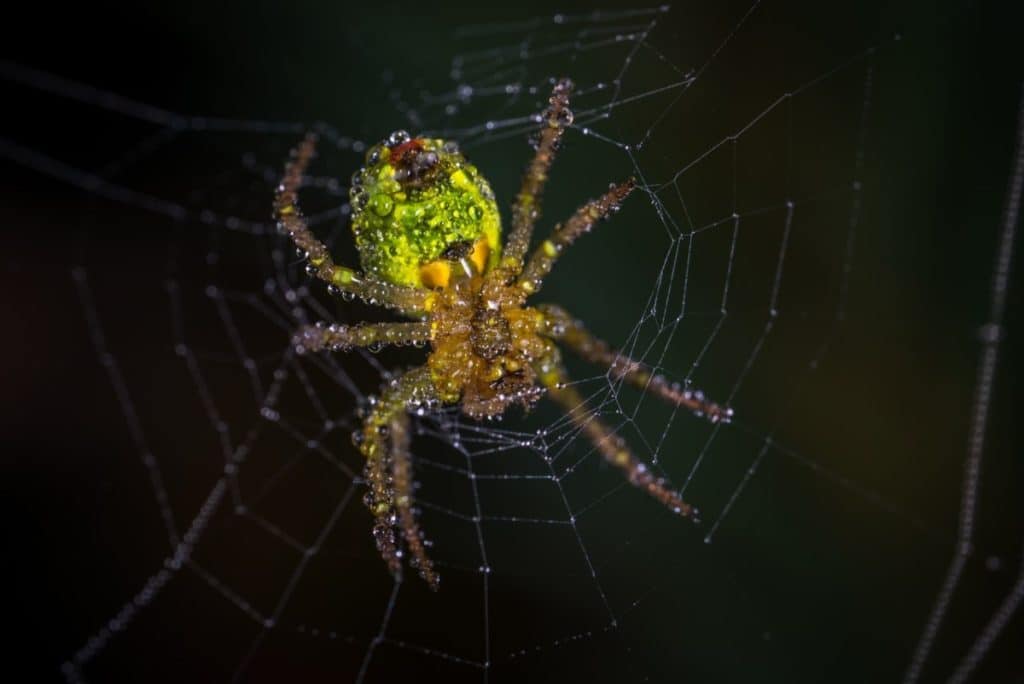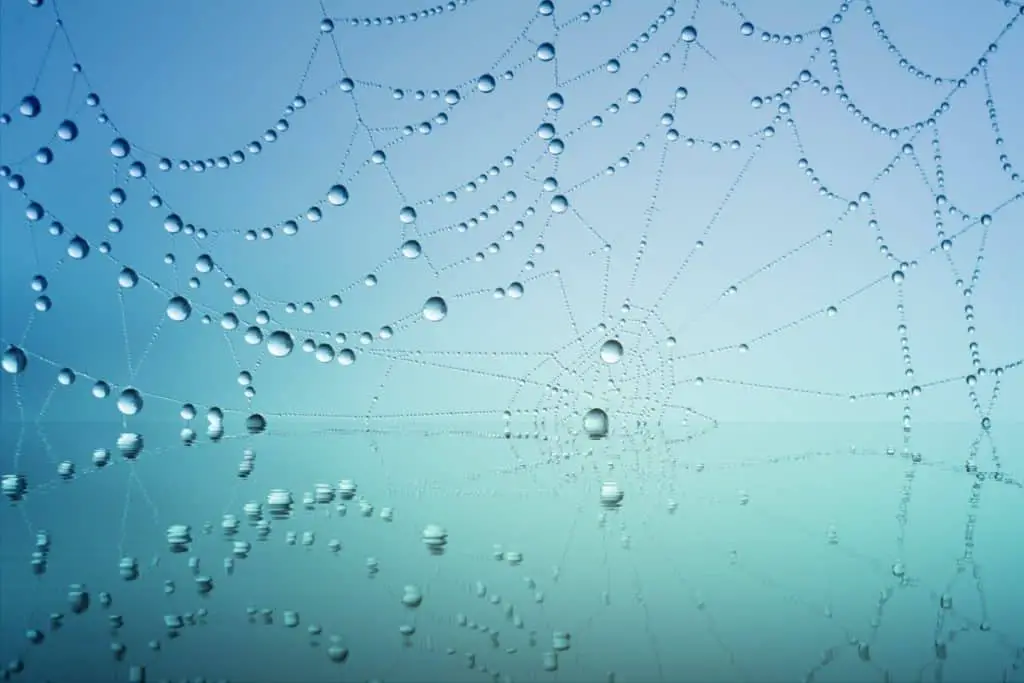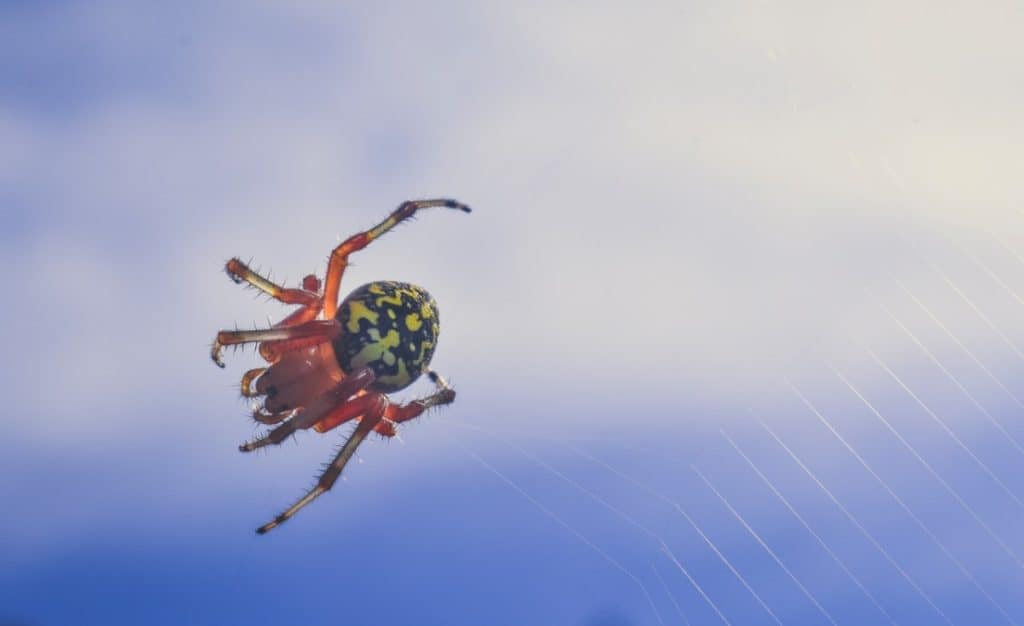
Spiders are among the most common arachnids found in our houses and compounds.
These types of arachnids construct webs that serve as their prey traps.
In this article, you’ll find out whether these spider webs are dangerous and if they can potentially harm humans or not.
So, is a spider web dangerous? Spider webs are in no way a threat to human beings. They are just impeccable creations made of strands of proteins and amino acids. They will, however, be dangerous to various insect species as insects are a spider’s main food source.
Some discoveries have even shown that applying a spider web to a wound can help stop the bleeding.
However, this is only practical for very small cuts.
Spiders produce different types of silk for different purposes.
Naturally, this silk is considered the strongest fiber produced by an animal.
For insects, however, it can be hard to break free from a spider web.
Flying insects, such as mosquitoes, are the most vulnerable victims as their wings create an “electric charge” as they fly.
This charge acts as an attraction towards the spider web, and the insect ends up being sucked into the sticky silk.
Some studies have also shown that some spiders lace their webs with dangerous chemicals that could subdue or be lethal to their prey.
Whilst others produce a chemical repellent to keep their competitors away from their webs.
The repellant, known as 2-pyrrolidinone, is responsible for keeping moths, caterpillars, ants, and other insects away from the spider’s web.
Why are spider webs not dangerous to human beings?
The spider webs consist of just strands of proteins and amino acids which means that spider webs are not dangerous to human beings.
How the webs are designed will mesmerize you.
However, sometimes vectors (disease-carrying insects) may be trapped in the spider webs in your home.
This could pose a risk if the vector in question is still alive when you walk into it.
Although the webs are not directly dangerous to people, they may cause hysteria to those who are very fearful.
Some spiders create very thick and dense webs.
These may present the risk of catching and spreading fire if they are constructed close to an ignition point.
Some webs even produce unpleasant smells around the house.
You can agree that having too many cobwebs in your house or compound is an indication that you need to do some thorough cleaning.
What makes spider webs dangerous to insects?
From research conducted by scientists, some spider webs are laced with neurotoxins that can subdue or be lethal to prey within a short time.
Besides these chemicals, the webs are made of light yet strong material. This is why it is so hard for prey to break free from the web.
Flies are particularly vulnerable to getting stuck on spider webs.
This is because when they flap their wings, they generate an “electric charge”, which acts as the medium of attraction between the insect and the spider web.
Some research shows that the most common spider species found in people’s houses are cobwebs and cellar spiders.
Both species are known to construct webs and patiently wait for prey to get stuck.
Cellar spiders sometimes go hunting by mimicking prey to attract other spiders that they can feed on.
We may know spiders as general predators, eating whatever lands on their webs.
However, these arachnids are known to consume disease-carrying insects and disturb pests.
Some jumping spiders are even known to prefer feasting on blood-filled mosquitoes that spread malaria in African homes.
Therefore, killing these arachnids may mean that you have removed an important predator from your home.
If you can’t get enough of learning about spiders then I encourage you to check out the “Spiders Category Page” which consists of various articles that give answers to spider-related questions.
Do the spiders get stuck on the webs too?
Spiders are not immune to silk. So, they can get stuck on their webs or those of fellow spiders like any other insects can.
Nevertheless, spiders know which threads are meant for intricate catching spirals, and they can avoid those threads as they are laced with glue.
This is how spiders avoid getting stuck in their webs.

Why are there so many spider webs in my compound?
Spiders make webs to capture prey.
Therefore, if you see many spider webs outside or in your house then that’s a sign that there are a lot of bugs, flies, and other pests present that the spiders are after.
The next step in removing the spiders would, of course, then be to get rid of the bugs as this will result in the spiders leaving as well.
Can spiders run out of the web?
You can be sure that spiders can run out of their webs whenever the situation asks them to do so.
They’ll, for example, run out of their webs whenever there is a potential threat to their lives.
Is there a difference between a spider web and a cobweb?
Generally, spider webs are those that are clean and still in use, while cobwebs are those rusty, deserted, and out of use webs.
Cobwebs can often easily be identified as these types of webs are full of dust which is the result of the web maker not caring for the web anymore.
How long does a spider take to construct an orb web?
The speed of making a web varies from one spider to the other. However, the average time taken by spiders to build a silk-threaded web is one hour.
You’ll often see spiders preparing their webs whenever the sun starts to go down as making webs close by lamps can attract a lot of insects once it gets dark outside.
Check out the video below if you want to see a time-lapse of an orb spider creating a web.
Are spider webs poisonous?
The silk produced by spiders when making their webs is sticky and amazingly elastic. These two features are enough to catch and retain prey.
However, the webs act as more than just pests and insect traps.
Research reveals that spiders that make orb webs use neurotoxins during construction.
A study conducted in 2011 showed that the golden orb weavers found in Asia and Australia inject a chemical repellant into their webs for self-defense and to keep other crawlers away from their food.
This repellant is known as 2-pyrrolidinone and it repels caterpillars, ants, moths, and many more unwanted insects.
Nonetheless, this is a common phenomenon among large spiders who construct thick and sturdy webs.
Using repellants is not common among smaller spiders with fragile webs that cannot support even an ant’s weight.
Orb weavers are a type of spider known to exude seven different silk threads for various purposes.
Such purposes include egg protection, sticky prey capturing, and web scaffolding.
Some researchers analyzed the seven glands that produce these threads and they found some amount of neurotoxin-proteins that resembled those found in spider venom.
These are the toxins that are found on the spider webs appearing as drops of sticky oil.
When the substances were tested on a bee, they had paralytic and lethal effects.
It is vital to note, however, that these neurotoxins are too weak to cause any harm to a human being.
So, the webs of, for example, orb-weaver spiders can indeed be poisonous to caught prey.
Do spider webs have germs?
Spider webs can be used to cover small wounds and prevent bleeding.
This is the case because besides that these spider webs inhibit the growth of bacteria, these webs are also non-inflammatory, biodegradable, and non-antigenic.
This goes to show that the webs have no germs and that they are safe to use by human beings.

Are cobwebs dangerous?
As discussed above, there is a slight difference between cobwebs and spider webs.
Cobwebs are those that are deserted by their builders and that is therefore no longer in use.
On the other hand, spider webs are those that have been built recently and are still in use.
Unlike spider webs, cobwebs can become unsafe for human beings and they should therefore be removed as soon as they are identified.
Since they have been abandoned for some time, they cannot capture insects.
With time, they become so dirty and clogged with dust, allergens, and other irritants.
You could be inhaling all that dust and the particles that come with it.
That could affect your lungs, leading to dust-related health complications.
Therefore, it is advisable to sweep down any cobwebs that you find in your house to avoid risking your health and that of your family.
Using a vacuum cleaner is the best alternative to a broom when it comes to getting rid of cobwebs.
Most vacuum cleaners come with a long extension that is perfect for sucking these pesky structures.
The most important rule then is to remember to clean your vacuum cleaner thoroughly once you have removed all the cobwebs.
Are spider webs antibacterial?
Spider webs have a remarkable characteristic: they are decay-resistant.
Some prior research has shown that abandoned webs remain intact and are not eaten by bacteria because of the antibiotics that are present on the silk threads.
However, studies that were conducted later revealed that spider webs use an impermeable barrier to lock in the nutrients, making them inaccessible to the bacteria.
Hence, the bacteria end up dying.
So, all in all, it can be said that spider webs are antibacterial because bacteria are unable to survive once they are present on a spider’s web.
Conclusion
Spider webs are indeed some of the most remarkable fibers that are produced by animals.
Despite being light, these webs are packed with strength that surpasses all other fibers.
In the questions that were covered above, we have read that spider webs are not dangerous, at least not to human beings.
However, spiders construct these webs for different purposes, including covering their eggs and trapping prey.
On the other hand, cobwebs pose a health risk to humans as they attract a lot of dust over time.
You should, therefore, always make an effort to clear all the cobwebs from your house.

